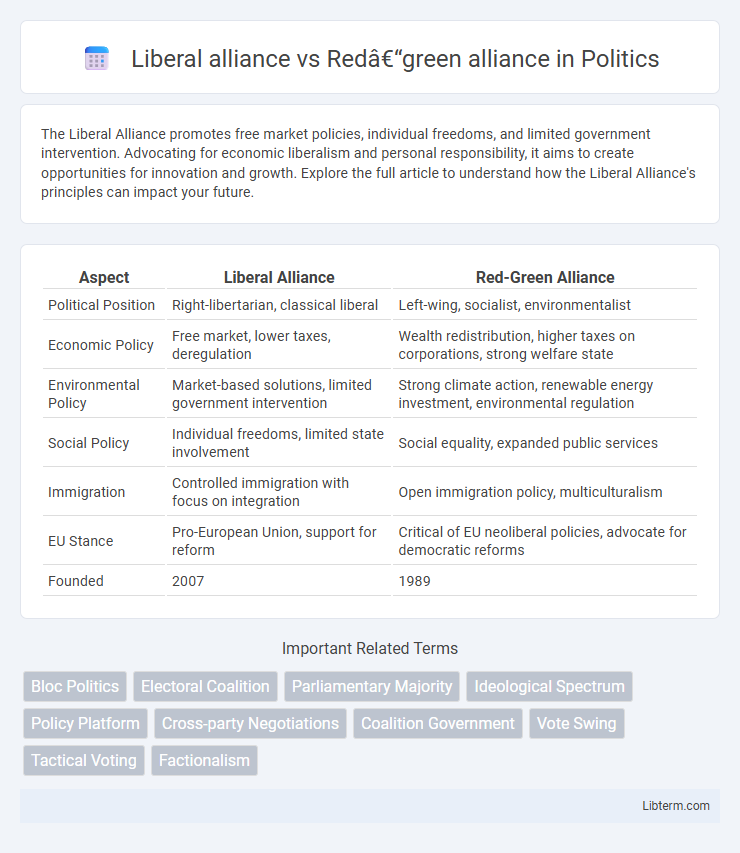The Liberal Alliance promotes free market policies, individual freedoms, and limited government intervention. Advocating for economic liberalism and personal responsibility, it aims to create opportunities for innovation and growth. Explore the full article to understand how the Liberal Alliance's principles can impact your future.
Table of Comparison
| Aspect | Liberal Alliance | Red-Green Alliance |
|---|---|---|
| Political Position | Right-libertarian, classical liberal | Left-wing, socialist, environmentalist |
| Economic Policy | Free market, lower taxes, deregulation | Wealth redistribution, higher taxes on corporations, strong welfare state |
| Environmental Policy | Market-based solutions, limited government intervention | Strong climate action, renewable energy investment, environmental regulation |
| Social Policy | Individual freedoms, limited state involvement | Social equality, expanded public services |
| Immigration | Controlled immigration with focus on integration | Open immigration policy, multiculturalism |
| EU Stance | Pro-European Union, support for reform | Critical of EU neoliberal policies, advocate for democratic reforms |
| Founded | 2007 | 1989 |
Introduction to the Liberal Alliance and Red–Green Alliance
The Liberal Alliance is a Danish political party advocating for classical liberalism, emphasizing free market policies, individual freedoms, and reduced government intervention. The Red-Green Alliance, by contrast, is a left-wing political coalition promoting democratic socialism, environmental sustainability, and social justice through expanded welfare programs and green policies. Both parties play significant roles in Denmark's political spectrum, representing differing approaches to economic management and social welfare.
Historical Background and Formation
The Liberal Alliance, established in 2007, emerged as a center-right liberal political party in Denmark advocating for free-market policies and individual liberties. In contrast, the Red-Green Alliance, founded in 1989, is a left-wing coalition uniting socialist, communist, and environmentalist groups aiming to promote social justice and ecological sustainability. Both parties originated in different political climates, with the Liberal Alliance arising from a split in the Danish Liberal Party while the Red-Green Alliance formed through the merger of multiple leftist factions seeking unified opposition.
Core Ideologies and Philosophies
The Liberal Alliance emphasizes individual freedom, free-market capitalism, and minimal government intervention, advocating for lower taxes and deregulation to promote economic growth. In contrast, the Red-Green Alliance prioritizes social justice, environmental sustainability, and wealth redistribution, supporting strong welfare policies and ecological reforms to address inequality and climate change. These divergent core ideologies shape their respective approaches to policy and governance, highlighting liberal economic principles versus progressive socialism and green politics.
Economic Policies Compared
The Liberal Alliance advocates for lower taxes, reduced government spending, and deregulation to stimulate economic growth and entrepreneurship. The Red-Green Alliance supports increased public investment, stronger welfare programs, and higher taxes on the wealthy to promote social equity and environmental sustainability. Economic policies differ fundamentally, with the Liberal Alliance emphasizing market-driven solutions while the Red-Green Alliance prioritizes state intervention and redistribution.
Social and Welfare Policies
The Liberal Alliance advocates for reduced government intervention in social and welfare policies, promoting individual responsibility and market-based solutions to enhance economic freedom and efficiency. In contrast, the Red-Green Alliance emphasizes expansive welfare programs, increased public spending on healthcare, education, and social security to ensure equitable access and support for vulnerable populations. These opposing approaches reflect fundamental differences in prioritizing personal autonomy versus collective social welfare within Denmark's political landscape.
Environmental and Climate Agendas
The Liberal Alliance promotes market-based solutions and emphasizes innovation and technology to address environmental challenges, advocating for reduced regulation to foster green entrepreneurship. The Red-Green Alliance prioritizes comprehensive climate action through significant government intervention, pushing for aggressive policies to reduce carbon emissions and transition to renewable energy sources. Their differing approaches reflect a tension between free-market environmentalism and eco-socialist strategies aimed at combating climate change.
Immigration and Integration Stances
The Liberal Alliance advocates for stricter immigration controls, emphasizing the need for efficient integration policies that prioritize language acquisition and labor market participation. In contrast, the Red-Green Alliance supports more open immigration policies and comprehensive social integration measures, including expanded welfare access and anti-discrimination efforts. These divergent stances reflect their broader ideological commitments to free-market individualism versus social equality and collective support.
Key Supporter Demographics
The Liberal Alliance predominantly attracts younger, urban voters with higher education levels who prioritize economic liberalism and individual freedoms. The Red-Green Alliance garners strong support from working-class communities, environmentally conscious individuals, and younger voters advocating for social justice and comprehensive welfare policies. Both parties find notable backing among progressive youth, yet they diverge distinctly in economic and environmental policy preferences.
Influence on National and European Politics
The Liberal Alliance champions free-market policies and individual liberties, impacting national legislation by pushing for economic deregulation and reduced government intervention in Denmark. Their pro-EU stance promotes deeper integration and market-oriented reforms within European institutions, aiming to strengthen Denmark's influence in EU economic policy-making. Conversely, the Red-Green Alliance emphasizes social justice and environmental sustainability, shaping national politics through advocacy for welfare expansion and climate action, while advocating for a more socially responsible and regulated EU framework.
Future Prospects and Political Impact
The Liberal Alliance is poised to influence Denmark's economic policies with its market-oriented reforms and emphasis on reducing public spending, potentially attracting business-friendly voters in upcoming elections. In contrast, the Red-Green Alliance focuses on strengthening social welfare and environmental sustainability, aiming to mobilize progressive voters concerned with climate change and inequality. Both alliances are expected to shape Denmark's political landscape by driving debates on fiscal responsibility and social justice, impacting coalition dynamics and legislative priorities.
Liberal alliance Infographic

 libterm.com
libterm.com